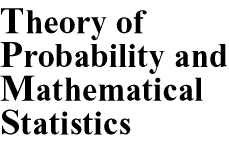Two-boundary problems for a random walk with negative geometric jumps
Author:
T. V. Kadankova
Translated by:
V. Semenov
Original publication:
Teoriya Imovirnostei ta Matematichna Statistika, tom 68 (2003).
Journal:
Theor. Probability and Math. Statist. 68 (2004), 55-66
MSC (2000):
Primary 60G50, 60J50
DOI:
https://doi.org/10.1090/S0094-9000-04-00604-0
Published electronically:
June 10, 2004
MathSciNet review:
2000395
Full-text PDF Free Access
Abstract |
References |
Similar Articles |
Additional Information
Abstract: Two-boundary problems for a random walk with negative geometric jumps are considered, and the corresponding results for a usual semicontinuous random walk are generalized for them. The following results are obtained: the probability distribution of ruin is found and expressed in terms of the lower and upper boundaries; formulas are given for the joint distribution of the infimum, supremum, and the walk itself at an arbitrary time instance; the transient probabilities and ergodic distribution are evaluated for the process describing the evolution of the random walk with two boundaries.
- Lajos Takács, Combinatorial methods in the theory of stochastic processes, John Wiley & Sons, Inc., New York-London-Sydney, 1967. MR 0217858
- V. S. Koroljuk, Graniqnye zadaqi dlj slo+nyh puassonovskih processov, Izdat. “Naukova Dumka”, Kiev, 1975 (Russian). MR 0402939
- V. N. Suprun and V. M. Šurenkov, On the resolvent of a process with independent increments that is terminated at the time of exit to the negative half-line, Studies in the theory of random processes (Russian), Izdanie Inst. Mat. Akad. Nauk Ukrain. SSR, Kiev, 1976, pp. 170–174 (Russian). MR 0440712
- V. N. Suprun, The ruin problem and the resolvent of a killed independent increment process, Ukrain. Mat. Ž. 28 (1976), no. 1, 53–61, 142 (Russian). MR 0428476
- D. V. Gusak, Granichnī zadachī dlya protsesīv z nezalezhnimi prirostami na skīnchennikh lantsyugakh Markova ta dlya napīvmarkovs′kikh protsesīv, Trudi Īnstitutu Matematiki Natsīonal′noï Akademīï Nauk Ukraïni [Proceedings of the Institute of Mathematics of the National Academy of Sciences of the Ukraine], vol. 18, Natsīonal′na Akademīya Nauk Ukraïni, Īnstitut Matematiki, Kiev, 1998 (Ukrainian, with English and Ukrainian summaries). MR 1710395
Gu2 ---, On a generalized semicontinuous integer-valued Poisson process with reflection, Teor. Imovirnost. ta Matem. Statist. 59 (1998), 40–46; English transl. in Theor. Probability and Math. Statist. 59 (1999), 41–46.
- E. A. Pečerskiĭ, Certain identities that are connected with the exit of a random walk from a segment and from a half-interval, Teor. Verojatnost. i Primenen. 19 (1974), 104–119 (Russian, with English summary). MR 0341619
Kartash1 M. V. Kartashov, On ruin probabilities for a risk process with bounded reserves, Teor. Imovirnost. ta Matem. Statist. 60 (1999), 46–58; English transl. in Theor. Probability and Math. Statist. 60 (2000), 53–65.
- Frank Spitzer, Principles of random walk, 2nd ed., Springer-Verlag, New York-Heidelberg, 1976. Graduate Texts in Mathematics, Vol. 34. MR 0388547
- L. V. Kantorovič and V. I. Krylov, Priblizhennye metody vysshego analiza, Fifth corrected edition, Gosudarstv. Izdat. Fiz.-Mat. Lit., Moscow-Leningrad, 1962 (Russian). MR 0154389
- A. N. Širjaev, Veroyatnost′, “Nauka”, Moscow, 1980 (Russian). MR 609521
Tac1 L. Takács, Combinatorial Methods in the Theory of Stochastic Processes, Wiley, New York–London–Sydney, 1967.
Kr18 V. S. Korolyuk, Boundary Problems for Compound Poisson Processes, “Naukova Dumka”, Kiev, 1975. (Russian)
CuSh V. N. Suprun and V. M. Shurenkov, On the resolvent of a process with independent increments terminating at the moment when it hits the negative real semiaxis, Studies in the Theory of Stochastic Processes, Institute of Mathematics, Academy of Sciences of UkrSSR, Kiev, 1975, pp. 170–174. (Russian)
Cu V. N. Suprun, Ruin problem and the resolvent of a terminating process with independent increments, Ukr. Mat. Zh. 28 (1976), no. 1, 53–61; English transl. in Ukr. Math. J. 28 (1976).
Gu1 D. V. Gusak, Boundary Problems for Processes with Independent Increments Defined on Finite Markov Chains and for Semi-Markov Processes, Institute of Mathematics, National Academy of Sciences of Ukraine, Kyiv, 1998. (Ukrainian)
Gu2 ---, On a generalized semicontinuous integer-valued Poisson process with reflection, Teor. Imovirnost. ta Matem. Statist. 59 (1998), 40–46; English transl. in Theor. Probability and Math. Statist. 59 (1999), 41–46.
Pech1 E. A. Pecherskiĭ, Some identities related to the exit of a random walk from a segment and a semisegment, Teor. Veroyatnost. i Primenen. 19 (1974), no. 1, 104–119; English transl. in Theory Probab. Appl. 19 (1975), no. 1.
Kartash1 M. V. Kartashov, On ruin probabilities for a risk process with bounded reserves, Teor. Imovirnost. ta Matem. Statist. 60 (1999), 46–58; English transl. in Theor. Probability and Math. Statist. 60 (2000), 53–65.
S13 F. Spitzer, Principles of Random Walk, Springer-Verlag, Berlin–New York, 1976.
Kan1 L. V. Kantorovich and V. I. Krylov, Approximate Methods of Higher Analysis, “Nauka”, Moscow–Leningrad, 1962; English transl., Interscience Publishers, Inc./P. Noordhoff Ltd., New York/Gröningen, 1958.
Sh1 A. N. Shiryaev, Probability, “Nauka”, Moscow, 1980; English transl., Springer-Verlag, New York, 1984.
Similar Articles
Retrieve articles in Theory of Probability and Mathematical Statistics
with MSC (2000):
60G50,
60J50
Retrieve articles in all journals
with MSC (2000):
60G50,
60J50
Additional Information
T. V. Kadankova
Affiliation:
Faculty for Mechanics and Mathematics, Kyiv National Taras Shevchenko University, Academician Glushkov Avenue 6, Kyiv, Ukraine
Email:
t_thys@ukr.net
Received by editor(s):
September 27, 2002
Published electronically:
June 10, 2004
Article copyright:
© Copyright 2004
American Mathematical Society




